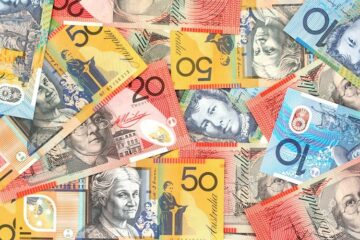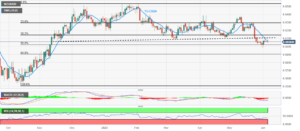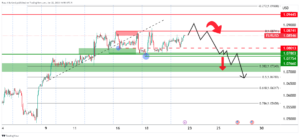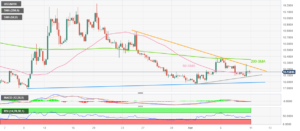
- Gold is under increasing bearish pressure after breaching the $2,000 level.
- Strong US employment figures have boosted US yields and the USD, weighing on Gold.
- Investors are cautious awaiting the outcome of the Fed’s monetary policy meeting.
Gold prices (XAU/USD) have opened the week in the same bearish tone seen at the end of the previous one. Friday’s upbeat US Nonfarm Payrolls (NFP) report, dampened investors’ hopes of Federal Reserve (Fed) cuts in early 2024, giving a fresh boost to US yields, to the detriment of the yieldless precious metal.
Bullion remains depressed below the $2,000 psychological level in the European trading session with traders in a cautious mood, awaiting US inflation data on Tuesday and the outcome of the Fed’s monetary policy meeting due on Wednesday.
Investors' sentiment is frail on Monday following the downbeat consumer inflation data from China over the weekend. The country’s CPI has shown its lowest growth in the last three years, reviving concerns that the uncertain situation in the world’s second-largest economy may bring global growth lower next year.
Beyond that, the escalating tensions in the Middle East are contributing to weigh on risk appetite, as we head into a week packed with central banks' decisions, starting with the Federal Reserve, on Wednesday.
Daily Digest Market Movers: Gold is turning lower with US yields and the US Dollar higher
- US employment beat expectations on Friday, with wage inflation rising well above expectations. This has curbed hopes of Fed cuts, giving a fresh boost to the US dollar and weighing on Gold.
- US Nonfarm Payrolls increased by 199K in November, beating expectations of a 180K rise, following a 150K increment in October.
- Hourly earnings accelerated 0.4%,m above the 0.3% market consensus from October’s 0.2%. This adds pressure to consumer prices and casts doubts about Fed cuts in the near term.
- According to the CME Group FedWatch Tool, futures markets are now pricing a 40% chance of a rate cut in March 2024, from the nearly 60% probability seen before the US NFP report.
- The US yields have bounced higher, with the benchmark 10-year US Treasury yield regaining 15 bps after the US NFP release and dragging the US Dollar higher and Gold lower with them.
- News, reporting attacks on US troops by Iran-backed militias in Iraq and Syria, is increasing fears about an escalation of the Gaza conflict, contributing to underpinning support to the safe-haven US Dollar.
- Traders are now looking at US consumer inflation figures ahead of the Fed's interest rate projections for more info about the bank’s monetary policy plans.
Technical Analysis: Gold looking increasingly vulnerable below $2,000
The technical picture shows Gold prices under increasing bearish pressure after breaching the $2,000 psychological level. The pair has breached below the 50 and 100 SMAs in 4-hour charts and is now pushing against the 200 SMA.
Further downtrend will push the precious metal towards a key support area at $1,982, where the 50% Fibonacci retracement of the October - December rally meets the neckline of a Head and Shoulders (H&S) pattern.
This is a common figure for trend shifts. A clear break of the neckline level would put bears in control, aiming for mid-November lows, at $1,934 ahead of $1,838 and the measured target of the H&S pattern at $1,851.
On the upside, above $2,000, the pair would meet resistance at $2,020 previous support, and $2.040.
US Dollar price today
The table below shows the percentage change of US Dollar (USD) against listed major currencies today. US Dollar was the weakest against the Pound Sterling.
| USD | EUR | GBP | CAD | AUD | JPY | NZD | CHF | |
| USD | 0.02% | -0.20% | -0.07% | 0.28% | 0.93% | 0.12% | 0.08% | |
| EUR | -0.02% | -0.22% | -0.11% | 0.26% | 0.91% | 0.10% | 0.06% | |
| GBP | 0.20% | 0.21% | 0.10% | 0.45% | 1.13% | 0.29% | 0.27% | |
| CAD | 0.07% | 0.12% | -0.10% | 0.35% | 1.04% | 0.20% | 0.18% | |
| AUD | -0.28% | -0.24% | -0.46% | -0.36% | 0.68% | -0.17% | -0.19% | |
| JPY | -0.97% | -0.94% | -1.25% | -1.01% | -0.64% | -0.84% | -0.88% | |
| NZD | -0.10% | -0.08% | -0.30% | -0.17% | 0.18% | 0.83% | -0.02% | |
| CHF | -0.08% | -0.06% | -0.28% | -0.18% | 0.18% | 0.87% | 0.02% |
The heat map shows percentage changes of major currencies against each other. The base currency is picked from the left column, while the quote currency is picked from the top row. For example, if you pick the Euro from the left column and move along the horizontal line to the Japanese Yen, the percentage change displayed in the box will represent EUR (base)/JPY (quote).
Gold FAQs
Gold has played a key role in human’s history as it has been widely used as a store of value and medium of exchange. Currently, apart from its shine and usage for jewelry, the precious metal is widely seen as a safe-haven asset, meaning that it is considered a good investment during turbulent times. Gold is also widely seen as a hedge against inflation and against depreciating currencies as it doesn’t rely on any specific issuer or government.
Central banks are the biggest Gold holders. In their aim to support their currencies in turbulent times, central banks tend to diversify their reserves and buy Gold to improve the perceived strength of the economy and the currency. High Gold reserves can be a source of trust for a country’s solvency. Central banks added 1,136 tonnes of Gold worth around $70 billion to their reserves in 2022, according to data from the World Gold Council. This is the highest yearly purchase since records began. Central banks from emerging economies such as China, India and Turkey are quickly increasing their Gold reserves.
Gold has an inverse correlation with the US Dollar and US Treasuries, which are both major reserve and safe-haven assets. When the Dollar depreciates, Gold tends to rise, enabling investors and central banks to diversify their assets in turbulent times. Gold is also inversely correlated with risk assets. A rally in the stock market tends to weaken Gold price, while sell-offs in riskier markets tend to favor the precious metal.
The price can move due to a wide range of factors. Geopolitical instability or fears of a deep recession can quickly make Gold price escalate due to its safe-haven status. As a yield-less asset, Gold tends to rise with lower interest rates, while higher cost of money usually weighs down on the yellow metal. Still, most moves depend on how the US Dollar (USD) behaves as the asset is priced in dollars (XAU/USD). A strong Dollar tends to keep the price of Gold controlled, whereas a weaker Dollar is likely to push Gold prices up.
- SEO Powered Content & PR Distribution. Get Amplified Today.
- PlatoData.Network Vertical Generative Ai. Empower Yourself. Access Here.
- PlatoAiStream. Web3 Intelligence. Knowledge Amplified. Access Here.
- PlatoESG. Carbon, CleanTech, Energy, Environment, Solar, Waste Management. Access Here.
- PlatoHealth. Biotech and Clinical Trials Intelligence. Access Here.
- Source: https://www.fxstreet.com/news/gold-remains-weak-after-us-employment-data-cooled-hopes-of-fed-cuts-202312111048
- :has
- :is
- :where
- $UP
- 000
- 1
- 100
- 15%
- 2%
- 200
- 2022
- 2024
- 33
- 41
- 50
- a
- About
- above
- accelerated
- According
- added
- Adds
- After
- against
- ahead
- aim
- Aiming
- along
- also
- an
- analysis
- and
- Animate
- any
- apart
- ARE
- AREA
- around
- AS
- asset
- Assets
- At
- Attacks
- awaiting
- Banks
- base
- BE
- bearish
- Bears
- beat
- been
- before
- began
- below
- Benchmark
- Biggest
- Billion
- boost
- Boosted
- both
- Box
- Break
- bring
- buy
- Buy Gold
- by
- CAN
- cautious
- central
- Central Banks
- Chance
- change
- Changes
- Charts
- China
- clear
- CME
- CME Group
- Column
- Common
- Concerns
- conflict
- Consensus
- considered
- consumer
- content
- contributing
- control
- controlled
- correlated
- Correlation
- Cost
- Council
- country’s
- CPI
- currencies
- Currency
- Currently
- Cut
- cuts
- data
- December
- decisions
- deep
- defensive
- depend
- Digest
- displayed
- diversify
- Doesn’t
- Dollar
- dollars
- down
- due
- during
- each
- Early
- Earnings
- East
- economies
- economy
- emerging
- employment
- enabling
- end
- ends
- escalate
- escalation
- EUR
- Euro
- European
- example
- exchange
- expanded
- expectations
- factors
- FAQ
- favor
- fears
- Fed
- Federal
- federal reserve
- Figure
- Figures
- following
- For
- fresh
- Friday
- from
- Futures
- futures markets
- geopolitical
- Giving
- Global
- Gold
- gold price
- Gold Prices
- good
- Government
- Group
- Growth
- Have
- head
- hedge
- High
- higher
- highest
- history
- holders
- hopes
- Horizontal
- How
- HTTPS
- if
- improve
- in
- increased
- increasing
- increasingly
- increment
- india
- inflation
- inflation figures
- Inflation rising
- info
- instability
- interest
- INTEREST RATE
- Interest Rates
- into
- investment
- Investors
- iraq
- Issuer
- IT
- ITS
- Japanese
- Japanese Yen
- jewelry
- jpg
- Keep
- Key
- Last
- left
- Level
- likely
- Line
- Listed
- looking
- lower
- lowest
- Lows
- major
- make
- map
- March
- March 2024
- Market
- Markets
- May..
- meaning
- measured
- medium
- medium of exchange
- Meet
- meeting
- Meets
- metal
- Middle
- Middle East
- module
- Monday
- Monetary
- Monetary Policy
- money
- mood
- more
- most
- move
- Movers
- moves
- Near
- nearly
- next
- nfp
- Nonfarm
- Nonfarm Payrolls
- November
- now
- october
- of
- on
- ONE
- opened
- or
- Other
- Outcome
- over
- packed
- pair
- Pattern
- Payrolls
- perceived
- percentage
- pick
- picked
- picture
- plans
- plato
- Plato Data Intelligence
- PlatoData
- played
- policy
- pound
- pound sterling
- Precious
- pressure
- previous
- price
- Prices
- pricing
- probability
- projections
- psychological
- purchase
- Push
- Pushing
- put
- quickly
- quote
- rally
- range
- Rate
- Rates
- recession
- records
- release
- rely
- remains
- report
- Reporting
- represent
- Reserve
- reserves
- Resistance
- retracement
- Rise
- rising
- Risk
- risk assets
- Role
- ROW
- s
- same
- second-largest
- seen
- sentiment
- session
- Shifts
- shine
- shoulders
- shown
- Shows
- since
- situation
- SMA
- SMAs
- Solvency
- Source
- specific
- Starting
- starts
- Status
- sterling
- Still
- stock
- stock market
- store
- store of value
- strength
- strong
- stronger
- such
- support
- Syria
- table
- Target
- Technical
- tend
- tends
- tensions
- term
- that
- The
- the Fed
- the world
- their
- Them
- this
- three
- times
- to
- today
- TONE
- tool
- top
- towards
- Traders
- Trading
- Treasuries
- treasury
- Trend
- Trust
- Tuesday
- turbulent
- Turkey
- Turning
- Uncertain
- under
- underpinning
- upbeat
- Upside
- us
- US Dollar
- us inflation
- us NFP
- US nonfarm payrolls
- US nonfarm payrolls (NFP)
- us treasuries
- US Treasury
- US yields
- Usage
- USD
- used
- usually
- value
- Vulnerable
- wage
- was
- we
- weaker
- Wednesday
- week
- weekend
- weigh
- weighing
- weighs
- WELL
- when
- whereas
- which
- while
- wide
- Wide range
- widely
- will
- with
- world
- World Gold Council
- world’s
- worth
- would
- XAU/USD
- year
- yearly
- years
- yellow
- Yen
- Yield
- yields
- you
- zephyrnet












